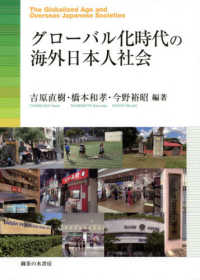Full Description
Offers a model for increasing equity in STEM education at the K-12 level in the United States.
In STEM Education in Underserved Schools, editor Julia V. Clark addresses an urgent national problem: the need to provide all students with a quality STEM education. Clark brings together a prestigious group of scholars to uncover the factors that impede equity and access in STEM education teaching and learning and provides research-based strategies to address these inequities.
This contributed volume demonstrates that students of color and those from lower socioeconomic communities have less access to qualified science and mathematics teachers, less access to strong STEM curriculum, less access to resources, and fewer classroom opportunities than their peers at other schools. Identifying the challenges and best practices related to producing more equitable and inclusive routes to access STEM education and professions, contributors explain how to positively impact the trajectory of individuals from underrepresented groups in K-12 and pre-college programs and lay out a bold reenvisioning of STEM education.
These essays aim to build knowledge and theory for how schools can promote coherent guidance for culturally responsive instruction by exploring the policies and practices of four nations—Finland, Singapore, Korea, and Australia—that have made noteworthy strides toward more equitable achievement in science and mathematics. Clark offers a powerful framework in STEM to capture the benefits of international collaborations that would embed American scientists and students in vibrant, globally collaborative networks. Through a deep analysis of successful programs elsewhere in the world and a uniquely international framework, Clark and these contributors present an innovative road map to equalize access to STEM education in the United States.
Contents
Foreword
Edmund W. Gordon
Acknowledgments
Chapter 1. An Overview of STEM Education in the United States
Julia V. Clark
Chapter 2. The Role of Assessment in Driving Change in STEM Teaching and Learning
Joseph Krajcik, Emily Adah Miller, and Susan Codere
Chapter 3. The Achievement Gap in Mathematics and Science: Barriers to a Quality STEM Education
Julia V. Clark
Chapter 4. Transforming Teaching and Learning in the STEM Classroom
Ellen B. Meier
Chapter 5. Science and Engineering Curriculum and Instruction That Promotes Equity and Justice: Hidden Spots, Bright Spots, Hot Spots, and Gathering Spots
Heidi B. Carlone and Elizabeth A. Davis
Chapter 6. Chronicling Education Challenges in STEM Education
Julia V. Clark
Chapter 7. Finnish Middle School Curriculum of STEM Subjects Emphasizes PISA and Transversal Competencies
Jari M. Lavonen and Do-Yong Park
Chapter 8. STEM Education in Singapore: Issues of Equity, Access, and Excellence
Jason Tan
Chapter 9. Building Synergies to Ensure Greater Access to Quality STEM Opportunities for All Australian Students
Debra Panizzon
Chapter 10. STEM Education Reform through International Innovation and Collaboration
Julia V. Clark
Chapter 11. Equity, Access, and Excellence: Making STEM a World-Class Education for All Students
Julia V. Clark
Contributors
About the Editor
Index






